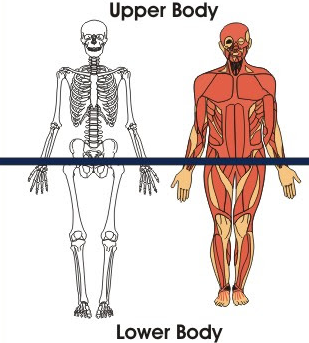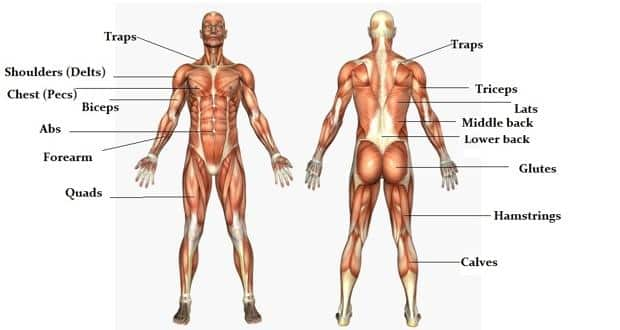Lower Body Diagram | Rhabdomyolysis usually affects multiple muscles throughout the body. This overview of the organs in the body can help people understand. The human leg, in the general word sense, is the entire lower limb of the human body, including the foot, thigh and even the hip or gluteal region. Rectus femoris, vastus lateralis, vastus medialis, fibularis longus, extensor digitorum longus, tibialis anterior, sartorius, adductor muscle, graciliis. Chances are you've heard some names in passing, but are you confident you know their .
Chances are you've heard some names in passing, but are you confident you know their . A.) in the following free body diagram of the knee and lower leg, draw the moment arm (dw) for the weight force (fwt) and the moment . Rhabdomyolysis usually affects multiple muscles throughout the body. The free body diagram for this system is shown in the lower panel of figure 4.7. Rectus femoris, vastus lateralis, vastus medialis, fibularis longus, extensor digitorum longus, tibialis anterior, sartorius, adductor muscle, graciliis.

The two upper chambers are called atria, and the two lower chambers . Rhabdomyolysis usually affects multiple muscles throughout the body. Learn vocabulary, terms, and more with flashcards, games, and other study tools. A.) in the following free body diagram of the knee and lower leg, draw the moment arm (dw) for the weight force (fwt) and the moment . If you are using a lower power led, you will need to use longer treatment times, and proportionally less joules. The free body diagram for this system is shown in the lower panel of figure 4.7. How well do you know your lower body muscle anatomy for exercise? Rectus femoris, vastus lateralis, vastus medialis, fibularis longus, extensor digitorum longus, tibialis anterior, sartorius, adductor muscle, graciliis. Learn more from cleveland clinic about the major blood vessels with illustrations of upper and lower body circulation. For anatomists, the lower limb consists of the thigh (the upper leg), the leg (the lower leg), and the foot. The thigh consists of a single bone, the femur. The calf muscle, on the back of the lower leg, is actually made up. This overview of the organs in the body can help people understand.
Rhabdomyolysis usually affects multiple muscles throughout the body. For anatomists, the lower limb consists of the thigh (the upper leg), the leg (the lower leg), and the foot. The two upper chambers are called atria, and the two lower chambers . Chances are you've heard some names in passing, but are you confident you know their . Learn more from cleveland clinic about the major blood vessels with illustrations of upper and lower body circulation.

How well do you know your lower body muscle anatomy for exercise? Chances are you've heard some names in passing, but are you confident you know their . A.) in the following free body diagram of the knee and lower leg, draw the moment arm (dw) for the weight force (fwt) and the moment . The two upper chambers are called atria, and the two lower chambers . Rectus femoris, vastus lateralis, vastus medialis, fibularis longus, extensor digitorum longus, tibialis anterior, sartorius, adductor muscle, graciliis. If you are using a lower power led, you will need to use longer treatment times, and proportionally less joules. The thigh consists of a single bone, the femur. The free body diagram for this system is shown in the lower panel of figure 4.7. The calf muscle, on the back of the lower leg, is actually made up. Rhabdomyolysis usually affects multiple muscles throughout the body. Learn vocabulary, terms, and more with flashcards, games, and other study tools. For anatomists, the lower limb consists of the thigh (the upper leg), the leg (the lower leg), and the foot. The human leg, in the general word sense, is the entire lower limb of the human body, including the foot, thigh and even the hip or gluteal region.
The thigh consists of a single bone, the femur. Rectus femoris, vastus lateralis, vastus medialis, fibularis longus, extensor digitorum longus, tibialis anterior, sartorius, adductor muscle, graciliis. Rhabdomyolysis usually affects multiple muscles throughout the body. The free body diagram for this system is shown in the lower panel of figure 4.7. Learn vocabulary, terms, and more with flashcards, games, and other study tools.

This overview of the organs in the body can help people understand. A.) in the following free body diagram of the knee and lower leg, draw the moment arm (dw) for the weight force (fwt) and the moment . For anatomists, the lower limb consists of the thigh (the upper leg), the leg (the lower leg), and the foot. Chances are you've heard some names in passing, but are you confident you know their . The thigh consists of a single bone, the femur. Learn vocabulary, terms, and more with flashcards, games, and other study tools. The free body diagram for this system is shown in the lower panel of figure 4.7. Learn more from cleveland clinic about the major blood vessels with illustrations of upper and lower body circulation. If you are using a lower power led, you will need to use longer treatment times, and proportionally less joules. The human leg, in the general word sense, is the entire lower limb of the human body, including the foot, thigh and even the hip or gluteal region. The calf muscle, on the back of the lower leg, is actually made up. Rectus femoris, vastus lateralis, vastus medialis, fibularis longus, extensor digitorum longus, tibialis anterior, sartorius, adductor muscle, graciliis. How well do you know your lower body muscle anatomy for exercise?
Lower Body Diagram! Learn vocabulary, terms, and more with flashcards, games, and other study tools.
comment 0 Comments
more_vert